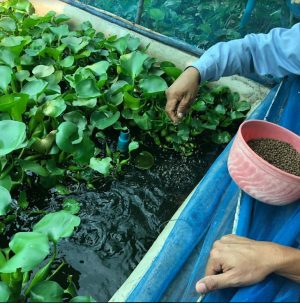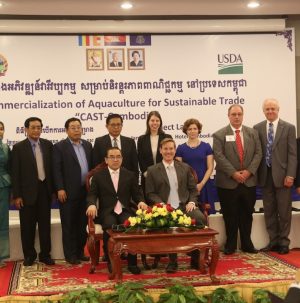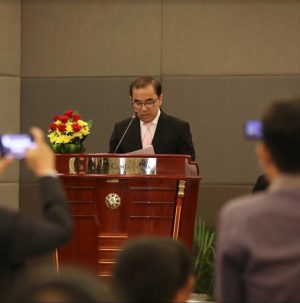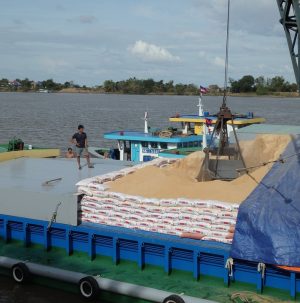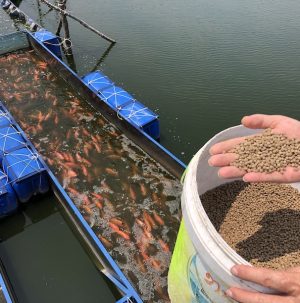Aquaculture
Under the Dome, Over-The-Top Results!
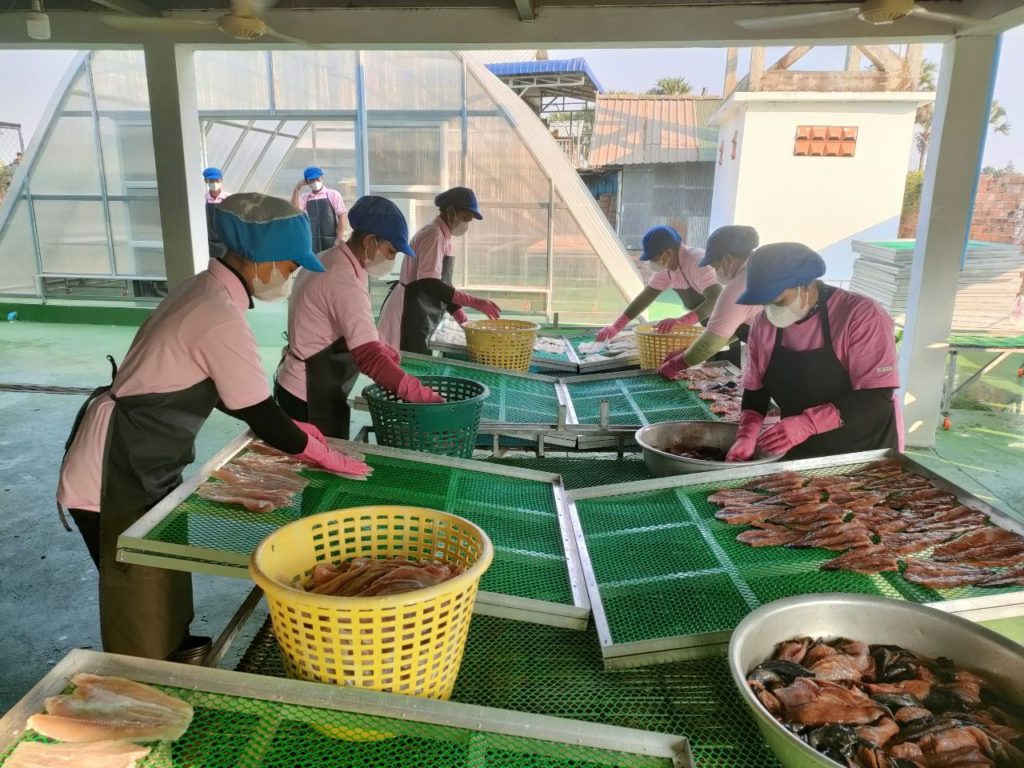
WISHH’s USDA-Food for Progress Commercialization of Aquaculture for Sustainable Trade-Cambodia Project is tackling multiple challenges in the country’s aquaculture industry with the introduction of solar domes for drying fish. Cambodia’s wet season spans May to October and is a major challenge to fish distributors and the farmers who depend upon them to market their fish. Typically, fish are dried outside on tables where they are exposed to the sun—and food safety hazards.
CAST partner World Vision Cambodia worked with Yorn Samnang, owner of fish distribution enterprise Samnang Sothea, to introduce a solar dome that was custom designed by Harvest The Sun to meet the food safety standards CAST champions. HTS and CAST collaborated and tested prior to introducing the solar dome at Samnang’s fish distribution business in Feb. 2022. He also received a matching grant through CAST that covered approximately 40% of the cost of the solar dome investment.
Since its installation, Samnang reports his productivity increased 300%—tripled!—compared to traditional drying without the solar dome. Importantly, the shorter drying times help prevent fish from spoiling, and he doesn’t have to worry about rain. He can now dry fish at night, too. Samnang’s business is now drying up to 90-120 kg (198-265 lb.) of fish per day, which is about 27-36 metric tons of dried fish per year. HTS calculates Samnang will recover his investment in 12-18 months. Samnang is excited to increase his supplies to help fill the growing demand for safe fish in Cambodia.
The solar dryer domes also contribute to climate change resilience. They reduce food spoilage and waste linked to greenhouse gases while using clean renewable energy to increase food production. CAST is now working with two more fish suppliers who will purchase solar domes with CAST matching grant funding. HTS is optimistic that, in addition to aquaculture, the new solar dome technology will prove useful to others in agriculture.
Cambodian Partnerships Lead Way for Aquaculture Expansion
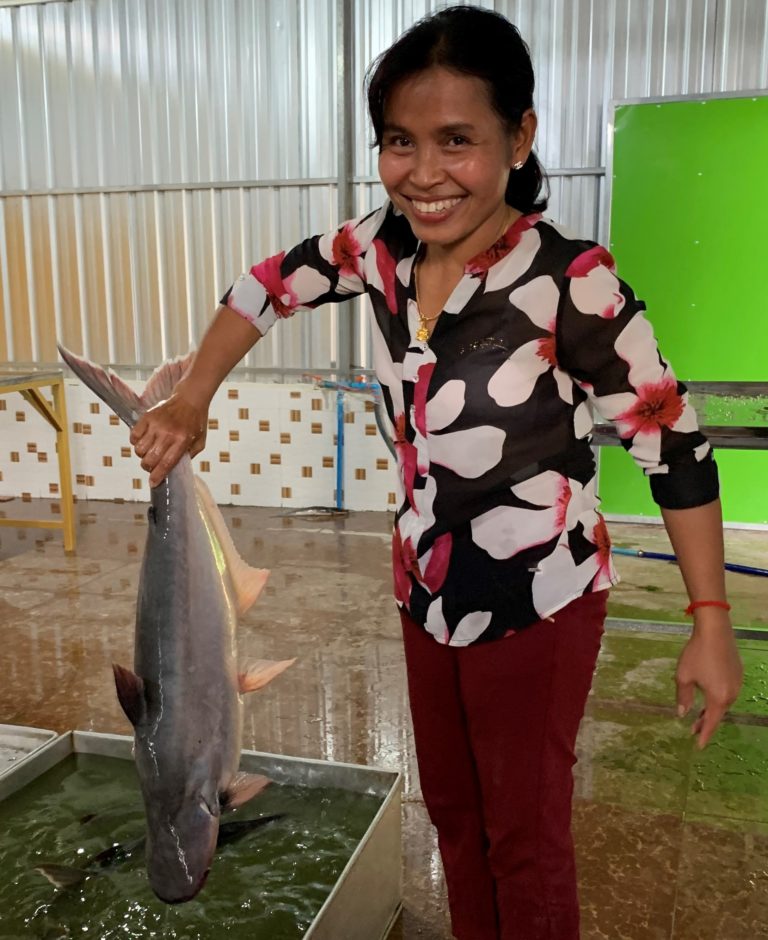
WISHH honors entrepreneurs, like aquaculture businesswoman Lim Bunny in Kampong Cham, Cambodia, who lead innovative food and feed enterprises. We thank Bunny for sharing her vision, advice, and how ASA/WISHH’s Commercialization of Aquaculture for Sustainable Trade-(CAST) Cambodia project is helping her grow her wholesale distribution business that now sells 2-3 tons of fish daily. Compared to last year, her sales revenue has increased by 30%.
CAST is a U.S. Department of Agriculture-funded Food for Progress project. Bunny is working through World Vision Cambodia, a CAST project partner. She joined the project to improve her 10-year-old business that employs 10 workers.
Current customers include families, local restaurants, and three industries that buy her fish for their workers. “My dream is getting my own brand and selling into big markets, such as supplying to supermarkets in the city. Until I met CAST, I didn’t have a mentor to help me grow my business into larger networks.”
Through CAST, Bunny has received guidance on business management and food safety standards, and other assistance that is helping her pursue the premium market with a high-quality fish product. CAST assisted her in creating a clear business plan that enables her to find her vision and niche. The plan also details specific action items, including logistics, transportation, marketing, and branding, and more. Additionally, CAST introduced Bunny to CAST’s financial partners who are assisting her with access to capital and other financial resources.
She received a loan from Chamroeun Microfinance and is using the money to improve the business with a new truck, water cleaning machine, and renovated electrical system and warehouse. “Because my goal is to reach premium markets, I had the idea of improving my facilities to improve my product quality.”
Another of Ms. Bunny’s goals is to promote local, farmed-raised fish, which will become the core of her brand identity. To achieve this, Bunny began purchasing good quality local fish from Cambodia’s Center of Excellence on Sustainable Agricultural Intensification and Nutrition (CE SAIN). CE SAIN is cooperating with Kansas State University, another CAST partner. She reports her customers favor the quality of the CE SAIN fish that she began purchasing in January 2021. “My customers like the CE SAIN fish even though the price is a little higher. When they hear that it is a locally raised fish, they are very happy because they want to support our local farmers.”
Bunny also joined the Cambodian Aquaculturist Association (CAA) that CAST helped launch in 2020. She says the association expands her network with other aquaculture businesses and keeps her current on industry information.
“This project [CAST] has accelerated me by guidance, advice, and actions,” she says. “It exceeds my expectations.
“So far, I have learned that I am a person who can make a bigger change than what I have ever done before.”
Bunny shares advice to help others. “I would encourage women to take part in the aquaculture business, and for those who are already involved, I want to recommend that you have to take a step before anyone else does because this is your chance. And another piece of advice is a woman can do everything a man does too.”
Fish are an integral component of the Cambodian diet. Wild capture currently accounts for 76 percent of the fish on the domestic market. Recognizing this system in unsustainable, Cambodian officials have focused their energies on increasing aquaculture production to meet the growing need for freshwater fish.
CAST (Commercialization of Aquaculture for Sustainable Trade), WISHH’s 5-year USDA-funded Food for Progress program, aims to address this challenge. Beginning in 2019, the CAST project is designed to accelerate production of high-demand fish species for the Cambodian market and develop a lasting aquaculture industry that recognizes the value of soy protein in feed. CAST will impact all aspects of the aquaculture value chain including 600 commercial fish farmers, input suppliers and the buyers of farmers’ fish production.
Cambodian CEO Launches Six New Fish Products with WISHH’s CAST Project
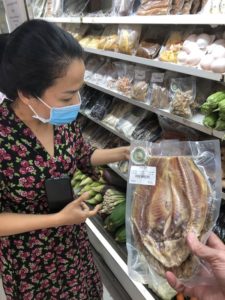
Home Taste Foods CEO Sim Sereirath is building supply chains and launching six new fresh and processed fish products in her retail store under the brand name Siem Reap Farmers Market. She has two outlets in Siem Reap and one in the active border town Poipet, near Thailand. Her business specializes in locally produced foods and has worked closely with ASA/WISHH’s Commercialization of Aquaculture for Sustainable Trade-Cambodia (CAST), a U.S. Department of Agriculture Food for Progress Project. She has also joined the CAST-supported Cambodian Aquaculturist Association.
CAST Cambodia’s Market Systems team has provided business development training, product promotional support and, most recently, training on improving food safety and sanitary/phytosanitary practices. “Thanks to the training I got from CAST, my business has been certified by the (Cambodian) Fisheries Administration as having ‘Good Hygiene Practices’ (GHP),” says Sereirath.
Siem Reap Farmers Market has bought fish from three different CAST-trained and supported producers. CAST is also helping Sereirath’s company produce an additional product made from small, dried silver barb fish for an organization that makes high-protein powder for food-insecure families.
CAST is also supporting her company’s efforts to introduce its products to Thailand’s export market. In partnership with another CAST-supported company, she is branding and selling Cambodian-raised pangasius fish that are dried under strict hygienic conditions using a new solar-powered dome. Sereirath has received inquiries from exporters interested in this high-quality, branded product.
“Many Cambodians also live in France and the USA; we want them to be able to buy our Cambodian-farmed and processed fish, too,” Sereirath proclaims.
CAST, a partnership between WISHH, World Vision, Kansas State University and Auburn University, will take lessons learned from WISHH’s trailblazing Pakistani aquaculture program and create a localized approach for Cambodia. WISHH will work as an incubator for new and growing businesses, providing critical technical assistance and bridging the links between key partners in the value chain.
WISHH sees great promise in the Cambodian market. The commitment from Cambodia’s Ministry of Agriculture sets this public-private partnership up for success, and the overall growth of the Cambodian economy holds great promise for U.S. soy.
Why 3 African Aquaculture Entrepreneurs
Dream Bigger

Jerry Geofrey Mang’ena, founder of Aqua-Farms Organization (AFO), says WISHH’s work with AFO on aquafeed allows them to “dream bigger” as they pursue Tanzania’s untapped potential for aquaculture.
“The success story of aquaculture can be like poultry in Tanzania,” says Mang’ena, a marine biologist and participant in the U.S. State Department’s 2019 Mandela Washington Fellowship Program.
WISHH used funds from the U.S. Department of Agriculture’s Foreign Market Development and Agricultural Trade Promotion programs to support the attendance of Mang’ena and 14 other African aquaculture industry professionals in Texas A&M University’s “Aquaculture Feed Extrusion, Nutrition & Feed Management” short course. Texas A&M had converted their popular in-person training program to a virtual format held August 31 – September 4, 2020.
Mang’ena and colleagues, Edwin Superius and John Kimaro, adjusted their work schedules to accommodate the training hours. Time well spent, they report.
“The basics we have obtained opened up our huge understanding on the technology and biology of making the best fish feeds,” says Mang’ ena. “This training has ignited us to speed up the establishment of the first industrial-scale production unit in Tanzania, and to build up our long-lasting collaboration with WISHH.”
Superius, a marine scientist, says he now knows the soybean is among the best plant-based protein sources for aquafeeds.
Kimaro, AFO’s resource manager, gained new insights that better aquafeeds require proper ingredients and formulations for each stage of fish growth. Different farming systems need customized fish feeds too.
Such knowledge is critical for AFO, which trains fish farmers on sustainable and economically competitive aquaculture practices. They started adopting the practices the morning after they completed the training. One new step they are taking is to assess the differences—including protein and moisture content—of their current two sources of feed. They are also evaluating protein content of different feeds they will use for various fish growth stages.
WISHH is continuing its work with the Texas A&M trainees through in-country technical assistance and opportunities for participation in future trade teams. Until they can meet in person, WISHH’s team of aquaculture consultants will continue answering technical questions through email and other communications tools.
The work offers important opportunities. The United Nation’s Food and Agriculture Organization reports, “Aquaculture in the United Republic of Tanzania has a vast but as yet untapped potential.” …“The contribution of the aquaculture sector to national food security and economic development is still insignificant.”
According to international research organization WorldFish, aquaculture in Tanzania produces 10,317 metric tons. Currently, 22,700 fishponds are used for aquaculture. WorldFish also reports low consumption of fish, at 7.6 kg/person/year in Tanzania, yet fish comprises 19.7% of the animal protein intake in the country.
Citing a 527% rise in global aquaculture production from 1990 to 2018, the State of the World’s Fisheries and Aquaculture (SOFIA) 2020 report affirms the trends driving WISHH’s work in aquaculture, including aqua feeds, in emerging and developing countries. The report states, “The priority should be to further develop aquaculture in Africa and in other regions where population growth will challenge food systems most.”
WISHH Plays Instrumental Role in Pakistan Aquaculture Industry Growth
As the 5th most populous country in the world with a growing middle class and impressive fall in poverty rates over the last decade, Pakistan holds vast opportunities for those working in emerging markets. While the population and economy of the country continue to grow, a protein gap remains. Pakistan needs to produce more protein in order to provide proper nutrition for the country’s citizens.
WISHH identified an opportunity to reduce the protein gap found in Pakistan through improvements to the aquaculture industry. WISHH’s work within the feed value chain resulted in an increased quality supply of soy-based aquaculture feed through improved production efficiency, which ultimately provides consumers access to safe, affordable fish protein.
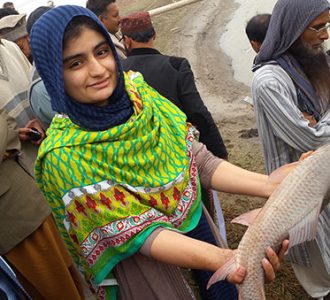
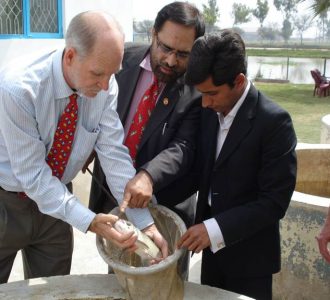
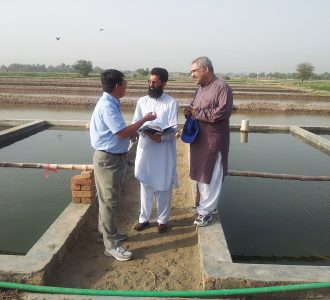
WISHH’s U.S. Department of Agriculture (USDA)-funded FEEDing Pakistan project improved capacity, productivity and quality in the Pakistani aquaculture sector with a focus on high quality fish feed produced with U.S. soy. Fish feed production grew from zero in 2011 to 24,000 MT in 2018. Today eight feed mills in Pakistan have a combined processing capacity of approximately 100,000 MT/year of soy-based fish feed. Despite comprising a very small percentage of the overall animal feed market, interest in aquaculture feed is expanding. Working closely with U.S. land grant universities, including: Kansas State, the University of Arizona and Auburn University, WISHH’s FEEDing Pakistan project helped increase the market value of fish produced—tilapia—from zero at the beginning of the project to an estimated $4.5 million USD within three years.
Consistent soybean supply plays a critical role in aquaculture and livestock sector intensification and resiliency in Pakistan and around the world. U.S. soybean trade with Pakistan complements locally-available feed ingredients to enhance aquaculture sector intensification. U.S. soybeans are currently being imported into Pakistan at record high rates and crushed locally – the value to the product added locally in Pakistan. Crushers’ largest customers are the Pakistani poultry (90%) and livestock feed industries (10%), with feed for aquaculture emerging as a new market. ASA/WISHH’s sister organization, the U.S. Soybean Export Council (USSEC), is active in Pakistan working with the crushing industry and the poultry feed sector. ASA/WISHH and USSEC remain committed to meeting current and future demand for soybeans which will stem from improvements in both the aquaculture and livestock feed sectors.
USDA estimated that the Pakistani aquaculture sector will grow 525% by 2022, requiring a subsequent increase in fish feed. As that growth in protein demand continues, U.S. soy will be there to meet current and future demand.

